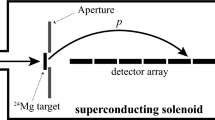Abstract
The Facility for Antiproton and Ion Research (FAIR, GSI) will not only provide future users with high fluxes of antiprotons in the high-energy range, but it is also intended to include a dedicated program for low-energy antiproton research in the keV regime, realized with the FLAIR project. The deceleration of antiprotons with an initial energy of 30 MeV down to ultralow energies of 20 keV will be realized in two steps. First, the beam is cooled and slowed down to an energy of 300 keV in a conventional magnetic ring, the Low energy Storage Ring (LSR) before being transferred into the electrostatic Ultralow energy Storage Ring (USR). In this synchrotron the deceleration to a final energy of 20 keV will be realized. This paper describes the ion-beam optical and mechanical layout of the beam extraction from the USR and summarizes the expected beam qualities of extracted beams.
Similar content being viewed by others
References
C. P. Welsch et al., “An Ultra-low-Energy Storage Ring at FLAIR,” Nucl. Instrum. Methods Phys. Res., Sect. A 546, 405–417 (2005).
C. P. Welsch et al., “Layout of the USR at FLAIR,” in Proceedings of Eur. Part. Accel. Conf. EPAC-2006, Edinburgh, Scotland, 2006, pp. 1636–1638.
C. P. Welsch et al., “Exploring Sub-femtosecond Correlated Dynamics with an Ultra-low Energy Electrostatic Storage Ring,” AIP Conf. Proc. 796, 266–271 (2005).
D. Fischer et al., GSI Scientific Report (Darmstadt, 2006).
C. P. Welsch and J. Ullrich, “FLAIR — A Facility for Low-Energy Antiproton and Ion Research at GSI,” Hyperfine Interact. 172, 71–80 (2007).
C. P. Welsch, “Ultra-low Energy Antiprotons at FLAIR,” in Proceedings of Eur. Part. Accel. Conf. EPAC-2004, Lucerne, Switzerland, 2004, pp. 1240–1242.
C. P. Welsch et al., “An Electrostatic Quadrupole Doublet with an Integrated Steerer,” in Proceedings of Eur. Part. Accel. Conf. EPAC-2004, Lucerne, Switzerland, 2004, pp. 1234–1236.
A. V. Smirnov and C. P. Welsch, “Cooling Rates of the USR as Calculated with BETACOOL,” AIP Conf. Proc. 821, 397–401 (2006).
C. P. Welsch et al., “Preliminary Design of Highly Flexible Extraction Scheme for the USR,” in Proceedings of Eur. Part. Acc. Conf. EPAC-2008, Genova, Italy, 2008, pp. 3407–3409.
A. I. Papash and C. P. Welsch, “On the Possibility of Realizing Shortest Bunches in Low-Energy Storage Rings,” Part. Nucl., Lett. 6, 216–226 (2009).
A. I. Papash et al., “On the Possibility of Realizing Shortest Bunches in Low-Energy Storage Rings,” in Proceedings of Eur. Part. Acc. Conf. EPAC-2008, Genova, Italy, 2008, pp. 334–336.
A. I. Papash and C. P. Welsch, “Investigations into the USR ’short Pulse Operation’ Mode,” in Proceedings of the Part. Acc. Conf. PAC-2009, Vancouver, Canada, 2009.
C. P. Welsch and A. I. Papash, “An Update of the USR Lattice: Towards a True Multi-user Experimental Facility,” in Proceedings of the Part. Acc. Conf. PAC-2009, Vancouver, Canada, 2009.
C. P. Welsch, A. I. Papash, and P. Schmid, “Preliminary Design Studies of an Extraction of the USR,” in Proceedings of Hyperfige Interact. LEAP-08 (Wien, 2008).
C. P. Welsch et al., “Development at the Interface between Accelerator Science and Atomic Physics within the QUASAR Group,” in GSI Scientific Report Atomic Physics-29 (2009), pp. 308–310.
G. A. Karamysheva and A. I. Papash, “Optimization of the Extraction System in the USR: Part 1. Fast Extraction Simulations,” www.quasar-group.org (2009).
G. A. Karamysheva and A. I. Papash, “Optimization of the Extraction System in the USR: Part 2. Slow Extraction Simulations,” www.quasar-group.org (2009).
“SIMION — Industry Standard Charged Particle Optics Simulation Software,” Scientific Instrument Services, http://www.simion.com.
OPERA3d User Guide, Vector Fields OPERA-3d, Version 12 (2008).
G. A. Karamysheva et al., “Beam Dynamic Simulations in Cyclotrons in the Frame of Matlab Software Package,” JINR Commun. P9-2008-52 (Dubna, 2008).
COMSOL Multiphysics.
L. M. Onischenko et al., “Cyclotron CYTRACK for the Membrane Production,” in Proceedings of 17th Intern. Conf. on Cyclotrons and Their Applications (Tokyo, 2004), pp. 96–99.
Y. Jongen et al., “Center Region Design of the Cyclotron C400 for Hadron Therapy,” in Proceedings of 18th Intern. Conf. on Cyclotrons and Their Applications (Catania, Italy, 2007), pp. 394–396.
P. Strolin, “Third-Order Resonance Slow Extraction from Alternating Gradient Synchrotrons,” CERN/PS/OP 80-10 Report (1980).
S. van der Meer, “Stochastic Extraction, a Low Ripple Version of Resonance Extraction,” CERN/PS//AA 78-6 Report (1978).
Author information
Authors and Affiliations
Additional information
The article is published in the original.
Rights and permissions
About this article
Cite this article
Karamysheva, G.A., Papash, A.I. & Welsch, C.P. Study of slow and fast extraction for the ultralow energy storage ring (USR). Phys. Part. Nuclei Lett. 8, 50–60 (2011). https://doi.org/10.1134/S1547477111010055
Received:
Published:
Issue Date:
DOI: https://doi.org/10.1134/S1547477111010055




